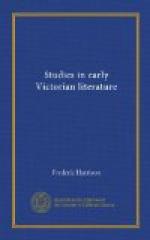Alton Locke was no doubt more popular, more passionately in earnest, more definite and intelligible than Yeast; and if I fail to hold it quite as the equal of Yeast in literary merit, it is because these very qualities necessarily impair it as a work of art. It was written, we well know, under violent excitement and by a terrible strain on the neuropathic organism of the poet-preacher. It is undoubtedly spasmodic, crude, and disorderly. A generation which has grown fastidious on the consummate finish of Esmond, Romola, and Treasure Island, is a little critical of the hasty outpourings of spirit which satisfied our fathers in the forties, after the manner of Sybil, the Last of the Barons, or Barnaby Rudge. The Tennysonian modulation of phrase had not yet been popularised in prose, and spasmodic soliloquies and melodramatic eloquence did not offend men so cruelly as they offend us now.
As Yeast was inspired by Sartor Resartus, so Alton Locke was inspired by Carlyle’s French Revolution. The effect of Carlyle upon Kingsley is plain enough throughout, down to the day when Carlyle led Kingsley to approve the judicial murder of negroes in Jamaica. Kingsley himself tells us, by the mouth of Alton Locke (chap. ix.), “I know no book, always excepting Milton, which at once so quickened and exalted my poetical view of man and his history, as that great prose poem, the single epic of modern days, Thomas Carlyle’s French Revolution.” Kingsley’s three masters were—in poetry, Tennyson; in social philosophy, Carlyle; in things moral and spiritual, Frederick D. Maurice. He had far more of genius than had Maurice; he was a much more passionate reformer than Tennyson; he was far more genial and social than Carlyle. Not that he imitated any of the three. Yeast is not at all copied from Sartor, either in form or in thought; nor is Alton Locke in any sense imitated from the French Revolution. It is inspired by it; but Yeast and Alton Locke are entirely original, and were native outbursts from Kingsley’s own fierce imagination and intense human sympathy.




